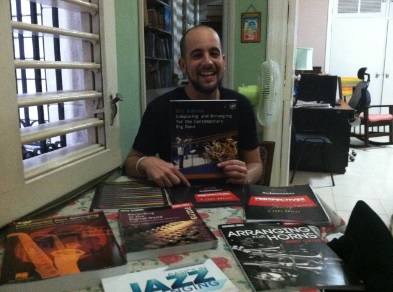
Jazz has been in Cuba for almost as long as jazz has existed. In fact, Cuban music was one of the contributors to the formation of jazz in its earliest years. (See Jelly Roll Morton’s comment on the essential role of the “Spanish tinge” in achieving the jazz feel.)
In spite of this long history, being a jazz musician in Cuba has not been easy for the last 55+ years since the free flow of audiences, musicians, records, and scores was cut off.
Cubans have extremely limited access to the Internet and the world market price of a single CD is the equivalent of a full week’s salary for them. Books, scores, and travel are correspondingly expensive and difficult to arrange.
While Cuba has an outstanding system for education in classical music (one of the best in the world), jazz education is carried out largely outside the academy and with little to no financial support.
How then does Cuba manage to produce so many world class jazz musicians?
Individual initiative and the passion and dedication of the country’s jazz community.
Growing the next generation of Cuban jazz musicians
Fledgling jazz musicians need the chance to learn their instruments, play with others, and master the theory that underpins the music.
One of the key figures in making these opportunities available to young people in Cuba today is Camilo Moreira, a friend of Jazz on the Tube.
A fine guitarist who has shifted his focus to education and composition, Camilo is a summa cum laude graduate of the Cuba’s top performing arts school University of the Arts (ISA) where he was recognized by the faculty as the best student-teacher of his graduating class.
Since 2010, he’s been teaching harmony, composition, computer music and ensemble practice at the country’s top conservatory for secondary students, the National School of Music (ENA). He also directs the school’s jazz band which was recently invited to perform at Jazz at Lincoln Center in April of 2016.
This year (2017), Camilo has taken on the important task of reviving and directing ISA’s Jazz Band. This is easily the most important jazz education initiative in the country.
How you can to help
As you can see from the picture above, Camilo likes books on composing, arranging and theory. They’re treasures to him.
For any of us, getting books on any subject is a simple matter of going to Amazon, spending a few bucks, and clicking send.
But there is no Amazon for Cubans and even if there were, a single music text can cost Camilo the equivalent of a month’s salary or more.
Up until now, that’s how he’s gotten his books, painstakingly saving his money and acquiring them catch-as-catch-can.
No more.
Jazz on the Tube has asked Camilo to give us his shopping list of the books he needs to continue his work as a teacher, arranger and composer.
We’re also on the lookout for scores and charts from, especially but not limited to, Machito and Mario Bauza, Tito Puente, Pérez Prado, and others who brought Cuban music into big band settings.
If you’re a promising young musician in Cuba, as a secondary student, you’re in ENA and as a university student, you’re in ISA. In both places Camilo is the face of jazz and we want to help him in his mission every way we can.
The power of positive leverage
It’s rare in life that such modest inputs (books and other support) have the potential to have such an oversized output.
If you’d like to be part of this project, please include a note to that effect with your next contribution to Jazz on the Tube and we’ll make sure the money you send is used for the purpose of supporting jazz education in Cuba.
By the way, in addition to being a first rate educator, Camilo is also an accomplished composer and arranger.
Using the old “sneaker net” method – flash drives passed from hand-to-hand instead of the Internet which as stated before is not easily accessed in Cuba – we’ve put some of his work online for you to enjoy.
Support Jazz on the Tube’s education projects in Cuba
Camilo wrote the score for the Cuban-made feature film “La Isla de Corcho” (“Cork Island”)
A Camilo Moreira composition and arrangement sung by Luna Manzanares: “Dejo Una Cancion”
Camilo Moreira wrote this one too: “El Trapezio de La Luna” Performed by friends and classmates from ISA. (A first reading.)
– Ken McCarthy
Jazz on the Tube
P.S. Our unique programming is made possible by help from people like you. Learn how you can contribute to our efforts here: Support Jazz on the Tube
Thanks.







